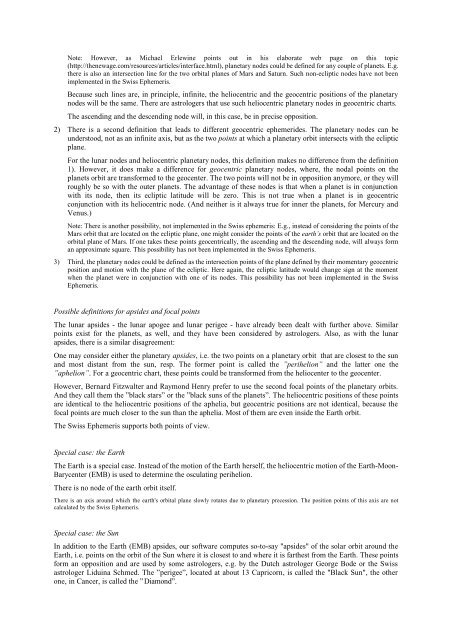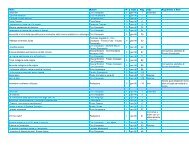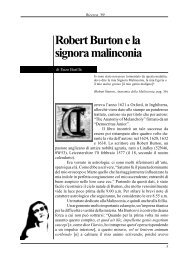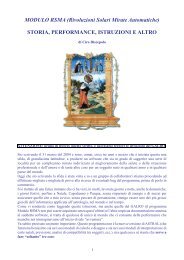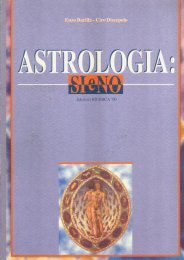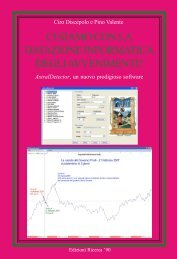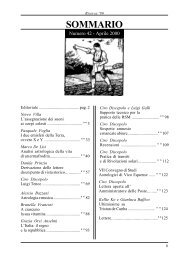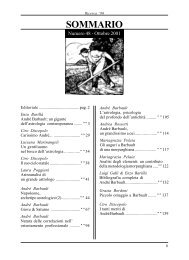Programming interface to the Swiss Ephemeris - programmiastral.com
Programming interface to the Swiss Ephemeris - programmiastral.com
Programming interface to the Swiss Ephemeris - programmiastral.com
Create successful ePaper yourself
Turn your PDF publications into a flip-book with our unique Google optimized e-Paper software.
Note: However, as Michael Erlewine points out in his elaborate web page on this <strong>to</strong>pic<br />
(http://<strong>the</strong>newage.<strong>com</strong>/resources/articles/<strong>interface</strong>.html), planetary nodes could be defined for any couple of planets. E.g.<br />
<strong>the</strong>re is also an intersection line for <strong>the</strong> two orbital planes of Mars and Saturn. Such non-ecliptic nodes have not been<br />
implemented in <strong>the</strong> <strong>Swiss</strong> <strong>Ephemeris</strong>.<br />
Because such lines are, in principle, infinite, <strong>the</strong> heliocentric and <strong>the</strong> geocentric positions of <strong>the</strong> planetary<br />
nodes will be <strong>the</strong> same. There are astrologers that use such heliocentric planetary nodes in geocentric charts.<br />
The ascending and <strong>the</strong> descending node will, in this case, be in precise opposition.<br />
2) There is a second definition that leads <strong>to</strong> different geocentric ephemerides. The planetary nodes can be<br />
unders<strong>to</strong>od, not as an infinite axis, but as <strong>the</strong> two points at which a planetary orbit intersects with <strong>the</strong> ecliptic<br />
plane.<br />
For <strong>the</strong> lunar nodes and heliocentric planetary nodes, this definition makes no difference from <strong>the</strong> definition<br />
1). However, it does make a difference for geocentric planetary nodes, where, <strong>the</strong> nodal points on <strong>the</strong><br />
planets orbit are transformed <strong>to</strong> <strong>the</strong> geocenter. The two points will not be in opposition anymore, or <strong>the</strong>y will<br />
roughly be so with <strong>the</strong> outer planets. The advantage of <strong>the</strong>se nodes is that when a planet is in conjunction<br />
with its node, <strong>the</strong>n its ecliptic latitude will be zero. This is not true when a planet is in geocentric<br />
conjunction with its heliocentric node. (And nei<strong>the</strong>r is it always true for inner <strong>the</strong> planets, for Mercury and<br />
Venus.)<br />
Note: There is ano<strong>the</strong>r possibility, not implemented in <strong>the</strong> <strong>Swiss</strong> ephemeris: E.g., instead of considering <strong>the</strong> points of <strong>the</strong><br />
Mars orbit that are located on <strong>the</strong> ecliptic plane, one might consider <strong>the</strong> points of <strong>the</strong> earth’s orbit that are located on <strong>the</strong><br />
orbital plane of Mars. If one takes <strong>the</strong>se points geocentrically, <strong>the</strong> ascending and <strong>the</strong> descending node, will always form<br />
an approximate square. This possibility has not been implemented in <strong>the</strong> <strong>Swiss</strong> <strong>Ephemeris</strong>.<br />
3) Third, <strong>the</strong> planetary nodes could be defined as <strong>the</strong> intersection points of <strong>the</strong> plane defined by <strong>the</strong>ir momentary geocentric<br />
position and motion with <strong>the</strong> plane of <strong>the</strong> ecliptic. Here again, <strong>the</strong> ecliptic latitude would change sign at <strong>the</strong> moment<br />
when <strong>the</strong> planet were in conjunction with one of its nodes. This possibility has not been implemented in <strong>the</strong> <strong>Swiss</strong><br />
<strong>Ephemeris</strong>.<br />
Possible definitions for apsides and focal points<br />
The lunar apsides - <strong>the</strong> lunar apogee and lunar perigee - have already been dealt with fur<strong>the</strong>r above. Similar<br />
points exist for <strong>the</strong> planets, as well, and <strong>the</strong>y have been considered by astrologers. Also, as with <strong>the</strong> lunar<br />
apsides, <strong>the</strong>re is a similar disagreement:<br />
One may consider ei<strong>the</strong>r <strong>the</strong> planetary apsides, i.e. <strong>the</strong> two points on a planetary orbit that are closest <strong>to</strong> <strong>the</strong> sun<br />
and most distant from <strong>the</strong> sun, resp. The former point is called <strong>the</strong> ”perihelion” and <strong>the</strong> latter one <strong>the</strong><br />
”aphelion”. For a geocentric chart, <strong>the</strong>se points could be transformed from <strong>the</strong> heliocenter <strong>to</strong> <strong>the</strong> geocenter.<br />
However, Bernard Fitzwalter and Raymond Henry prefer <strong>to</strong> use <strong>the</strong> second focal points of <strong>the</strong> planetary orbits.<br />
And <strong>the</strong>y call <strong>the</strong>m <strong>the</strong> ”black stars” or <strong>the</strong> ”black suns of <strong>the</strong> planets”. The heliocentric positions of <strong>the</strong>se points<br />
are identical <strong>to</strong> <strong>the</strong> heliocentric positions of <strong>the</strong> aphelia, but geocentric positions are not identical, because <strong>the</strong><br />
focal points are much closer <strong>to</strong> <strong>the</strong> sun than <strong>the</strong> aphelia. Most of <strong>the</strong>m are even inside <strong>the</strong> Earth orbit.<br />
The <strong>Swiss</strong> <strong>Ephemeris</strong> supports both points of view.<br />
Special case: <strong>the</strong> Earth<br />
The Earth is a special case. Instead of <strong>the</strong> motion of <strong>the</strong> Earth herself, <strong>the</strong> heliocentric motion of <strong>the</strong> Earth-Moon-<br />
Barycenter (EMB) is used <strong>to</strong> determine <strong>the</strong> osculating perihelion.<br />
There is no node of <strong>the</strong> earth orbit itself.<br />
There is an axis around which <strong>the</strong> earth's orbital plane slowly rotates due <strong>to</strong> planetary precession. The position points of this axis are not<br />
calculated by <strong>the</strong> <strong>Swiss</strong> <strong>Ephemeris</strong>.<br />
Special case: <strong>the</strong> Sun<br />
In addition <strong>to</strong> <strong>the</strong> Earth (EMB) apsides, our software <strong>com</strong>putes so-<strong>to</strong>-say "apsides" of <strong>the</strong> solar orbit around <strong>the</strong><br />
Earth, i.e. points on <strong>the</strong> orbit of <strong>the</strong> Sun where it is closest <strong>to</strong> and where it is far<strong>the</strong>st from <strong>the</strong> Earth. These points<br />
form an opposition and are used by some astrologers, e.g. by <strong>the</strong> Dutch astrologer George Bode or <strong>the</strong> <strong>Swiss</strong><br />
astrologer Liduina Schmed. The ”perigee”, located at about 13 Capricorn, is called <strong>the</strong> "Black Sun", <strong>the</strong> o<strong>the</strong>r<br />
one, in Cancer, is called <strong>the</strong> ”Diamond”.


